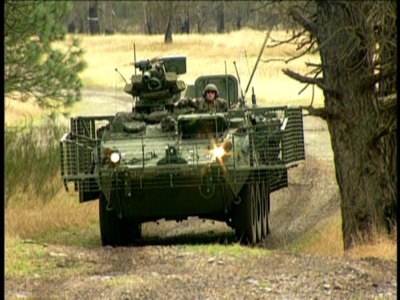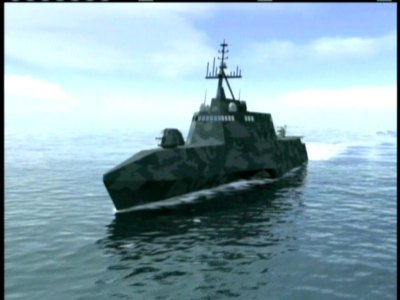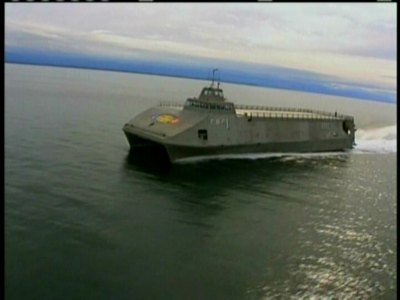| Reviews & Columns |
|
Reviews DVD TV on DVD Blu-ray 4K UHD International DVDs In Theaters Reviews by Studio Video Games Features Collector Series DVDs Easter Egg Database Interviews DVD Talk Radio Feature Articles Columns Anime Talk DVD Savant Horror DVDs The M.O.D. Squad Art House HD Talk Silent DVD
|
DVD Talk Forum |
|
|
| Resources |
|
DVD Price Search Customer Service #'s RCE Info Links |
|
Columns
|
|
|
Popular Mechanics: The New Technology of War
Koch Vision has released Popular Mechanics: The New Technology of War, a five-part, three-and-a-half-hour-plus documentary that looks at the quantum leaps the U.S. military is undertaking to bring cutting-edge computer technology to the armed services. Using CGI simulations, battle footage, authentic test and training films, and interviews with computer experts, Popular Mechanics: The New Technology of War moves quickly through its various examinations of ground, air, and sea operations innovations, focusing on individual weapons and vehicles that will simply astound the average viewer.

Popular Mechanics: The New Technology of War is broken up into five sections: Ground Forces; Air Power, Sea Power; Counter-Terrorism; and The Future of War. According to Popular Mechanics: The New Technology of War, the key to 21st warfare lies squarely on one key element: information superiority. I suppose that's always been the key to winning armed conflicts from man's first war, but in the 21st century, the concept of gathered intelligence has gone completely digital, with the military shooting for a day when the average boot soldier will be linked up to a central computerized, satellite-controlled grid - which controls all sea, land, and ground operations - while outfitted and equipped with state-of-the-art computerized weaponry and even nanotechnology-designed uniforms that serve as both armor and emergency aid equipment. What he sees on the ground will be convey to a central command, which controls all aspects of a particular engagement, with the soldier's computer intel providing vital info for the overall success of the operation.
Watching Popular Mechanics: The New Technology of War, I was floored by the future weapons, vehicles and computer technologies and operational systems that are either close to being implemented or are in their formative stages of development. Not being in any way an expert (or even a novice for that matter) on such subjects, frankly, my first reaction to seeing some of the incredibly advanced systems in Popular Mechanics: The New Technology of War was, "Hey, should they really be talking about this stuff out loud?" But I assume they know what they're doing (can you imagine the stuff they're not talking about?), and this documentary presents a fascinating, techno-junkie's paradise of super-cool weaponry, assault vehicles and operational systems (I'll comment on some of the items described in the doc, down in the individual section descriptions).
And since it comes from the producers of Popular Mechanics, even though it's a general overview of these coming technologies, there's plenty of emphasis on looking at the gadgets, and explaining in clear terms how they work (or will work). The first three sections that deal with specific military applications are probably the most compelling portions of the documentary, with the section on counter-terrorism coming off a little diffused (no doubt due to the less "sexy" aspects of airport x-ray machines versus stealth submarines) and the final section on the future of war plays more like a summing up of the previous four sections. But for a look at the fearsome, awesomely complicated weaponry and military systems that will be science fact not fiction in the next twenty years, Popular Mechanics: The New Technology of War is a perfect introduction.

Here are the 5, 47-minute sections of the two-disc documentary, Popular Mechanics: The New Technology of War, and my thoughts on each segment:
Ground Forces
Until robots start doing our killing on the battlefield (and according to Popular Mechanics: The New Technology of War, that day will be coming sooner than you think), the foot soldier is still the best "computer" we have, and the advanced systems being developed will catapult the average dog face into becoming a 21st century warrior. Evidently, the highest priority the U.S. military has right now is integrating all land, sea, and air operational systems into one centrally controlled system, guided by GPS and "Blue Force Tracking" (where each and every soldier can be tracked on the battlefield). This section also looks at The Stryker, an awesomely fierce armored personnel carrier/tank that can punch a whole in anything while hauling ass down the road at 70 miles-per-hour! I also found the discussion of the nanotechnology-designed "Liquid Armor" concepts utterly incredible, with talk of soldiers' uniforms that are as soft as silk, yet totally impervious to projectiles -- while literally acting as "health monitors" that could apply medically operations such as CPR to wounded soldiers. Seriously?
Air Power
More than any other component, speed is the absolute leveler in any armed air combat: the fastest jet wins. So the discussion of the new supersonic "scramjets -- where engineers predict hydrogen-compressed fuel systems that will produce speeds in excess of Mach 14 (!) - was fascinating. Stealth systems are also looked at, with the new Raptor fighter jets, as well as the F-22 and the infinitely adaptable F-35, providing some cool flight footage. Precision engagement is also discussed, with the AGM-130 and the JASSM "Fire and Forget" precision-guided bombing systems, looked at in detail. And wait until you see the X-45, the experimental unmanned stealth fighter jet.
Sea Power
Since 70% of the globe is covered in water, you had better have a navy that can go anywhere, deliver any ordinance, and get there quickly and silently. Popular Mechanics: The New Technology of War looks at the CDN-21, the new class of aircraft carriers that will soon replace the Nimitz carrier class. I particularly liked the new RQ8A "Fire Scout" robotic Navy helicopter scout that looks like a toy you might build in your garage - a very deadly little toy. The AAAV (Advanced Amphibian Assault Vehicle) is something to behold, a jacked-up landing craft that can hydroplane across the water as its mounted gun blasts targets at the landing zone. The DD6-1000 Navy destroyer class is fascinating, with its 100 mile range for in-land targeting, along with the highly advanced CG(X) cruiser class ships. The new Virginia Class Submarines are also detailed here (with the sweet Advanced SEAL Delivery System mini sub).
Counter-Terrorism
According to the experts, building a Fortress America isn't possible, or even the most effective way to deal with the absolutely frightening reality of Islamic terrorism. What can save us from another attack is upping our intelligence gathering capabilities, and all sorts of computer systems are looked at in this section, including the use of UAV's (Unmanned Aerial Vehicles) on the Mexican border, radar tracking systems for carrier boxes from overseas ships, advanced x-ray and electromagnetic "cat scan" machines at airports that can pinpoint weapons, explosives, and biological agents, and nuclear detection systems. My favorite technology? The distinctively "low-tech" use of bluegill fish to monitor our fresh water systems.
The Future of War
This section basically sums up the previous four segments, but there are some awesome new weapons and vehicles featured here, including the kick-ass "Crusher," a six-wheeled all-terrain unmanned assault vehicle that guides itself over rough territory, and the futuristic-looking FSF1 Sea Fighter.

The DVD:
The Video:
The full screen, 1.33 video image for Popular Mechanics: The New Technology of War is just okay, with compression issues popping up on a large monitor. The image wasn't the sharpest, either.
The Audio:
The Dolby Digital English mono audio mix was adequate for this dialogue-heavy doc, but I would have liked to hear those vehicle engines in 5.1.
The Extras:
There are no extras for Popular Mechanics: The New Technology of War.
Final Thoughts:
Military buffs and techno-junkies will enjoy Popular Mechanics: The New Technology of War, a five-part look at the coming advanced military systems, weapons and vehicles that will define American 21st century warfare. Since it's from Popular Mechanics, the emphasis is on giving detailed explanations for all the items looked at, with those explanations given in a clear, concise, easily understood manner. I recommend Popular Mechanics: The New Technology of War.
Paul Mavis is an internationally published film and television historian, a member of the Online Film Critics Society, and the author of The Espionage Filmography.


|
| Popular Reviews |
| Sponsored Links |
|
|
| Sponsored Links |
|
|
| Release List | Reviews | Shop | Newsletter | Forum | DVD Giveaways | Blu-Ray | Advertise |
|
Copyright 2024 DVDTalk.com All Rights Reserved. Legal Info, Privacy Policy, Terms of Use,
Manage Preferences,
Your Privacy Choices | |||||||













